Indulge in Creamy Lemon Chicken Orzo Pasta: Your New Favorite One-Pot Wonder
Craving a dish that’s both wonderfully comforting and effortlessly elegant? Look no further than this **Creamy Lemon Chicken Orzo Pasta**. It’s a harmonious blend of rich, savory flavors with a bright, zesty finish, designed to feel luxurious yet remain incredibly weeknight-friendly. Forget elaborate preparations; this one-pot sensation brings gourmet taste to your table with minimal fuss.
Our unique rendition elevates this classic comfort food, starting with a foundation that sets it apart: butter gently browned to a nutty perfection, followed by onions slowly caramelized with a touch of sugar until they’re soft and golden. This initial step builds a profound depth of flavor that resonates throughout the entire dish, transforming a simple meal into something truly special.

For ultimate convenience and a burst of flavor, we incorporate succulent shredded rotisserie chicken – yes, even some of that irresistible crispy skin! The orzo pasta then simmers directly in a vibrant lemony cream sauce, infused with aromatic garlic and savory chicken broth. To finish, a generous helping of freshly grated Parmesan cheese and tender spinach is stirred in, wilting just enough to add freshness and a beautiful green hue. The result? A perfectly balanced, incredibly creamy, and deeply satisfying meal that we’re confident you’ll adore.
Why You’ll Love This Lemon Chicken Orzo Pasta
This creamy lemon chicken orzo pasta isn’t just another dish; it’s a culinary experience designed for maximum enjoyment with minimal effort. Here’s why it stands out:
- Unmatched Depth of Flavor: Our secret weapon is the initial browning of butter, which creates a rich, nutty base, followed by slowly caramelized onions. This step lays the foundation for truly complex and satisfying flavors, making every bite a delight.
- Effortless and Flavorful Chicken: Utilizing shredded rotisserie chicken not only saves precious time but also adds an incredible depth of savory flavor, especially with a touch of its crispy skin mixed in. It’s convenience meets culinary excellence.
- Luxuriously Creamy Texture: Thanks to the generous use of heavy cream (also known as double cream), this pasta boasts an irresistibly velvety smooth sauce that perfectly coats every grain of orzo and piece of chicken.
- Generously Cheesy Goodness: We don’t hold back on the Parmesan! Plenty of freshly grated Parmesan cheese is stirred in, adding a salty, umami-rich dimension that complements the lemon and chicken beautifully.
- Ready in Record Time: Despite its sophisticated taste, this dish can be on your table in just over half an hour. It’s the ideal solution for busy weeknights when you want something homemade and delicious without spending hours in the kitchen.
- Versatile for Any Occasion: Simple enough for a relaxed weeknight dinner, yet impressive enough to serve guests on a special weekend, this lemon chicken orzo pasta truly hits all the right notes for any occasion.
Discover More Creamy & Comforting Pasta Dishes
If this creamy lemon chicken orzo has awakened your appetite for more rich, comforting dinners, we have a curated selection of favorites we think you’ll absolutely love. Each recipe offers its own unique twist on creamy pasta perfection, perfect for exploring new flavors and expanding your weeknight repertoire:
For a baked sensation, try our creamy chicken orzo pasta bake, which emerges from the oven golden and bubbling with cheesy goodness. If you’re seeking a dish with a delightful smoky and spicy kick, our creamy chicken and chorizo pasta is sure to impress. For those who appreciate a richer, more robust flavor profile, the creamy steak pasta with mushroom and whisky sauce offers an indulgent culinary adventure. And, living up to its enchanting name, the best marry me chicken pasta is truly irresistible, promising to become a cherished recipe in your household.
- Creamy Chicken Orzo Pasta Bake
- Creamy Chicken and Chorizo Pasta
- Creamy Steak Pasta Recipe (With Mushroom and Whisky Sauce)
- The Best Marry Me Chicken Pasta (Tuscan Chicken Pasta)
Essential Ingredient Notes & Smart Substitutions
Understanding the role of each ingredient is key to perfecting this creamy lemon chicken orzo pasta. Here’s a detailed look at the core components and how to handle them:
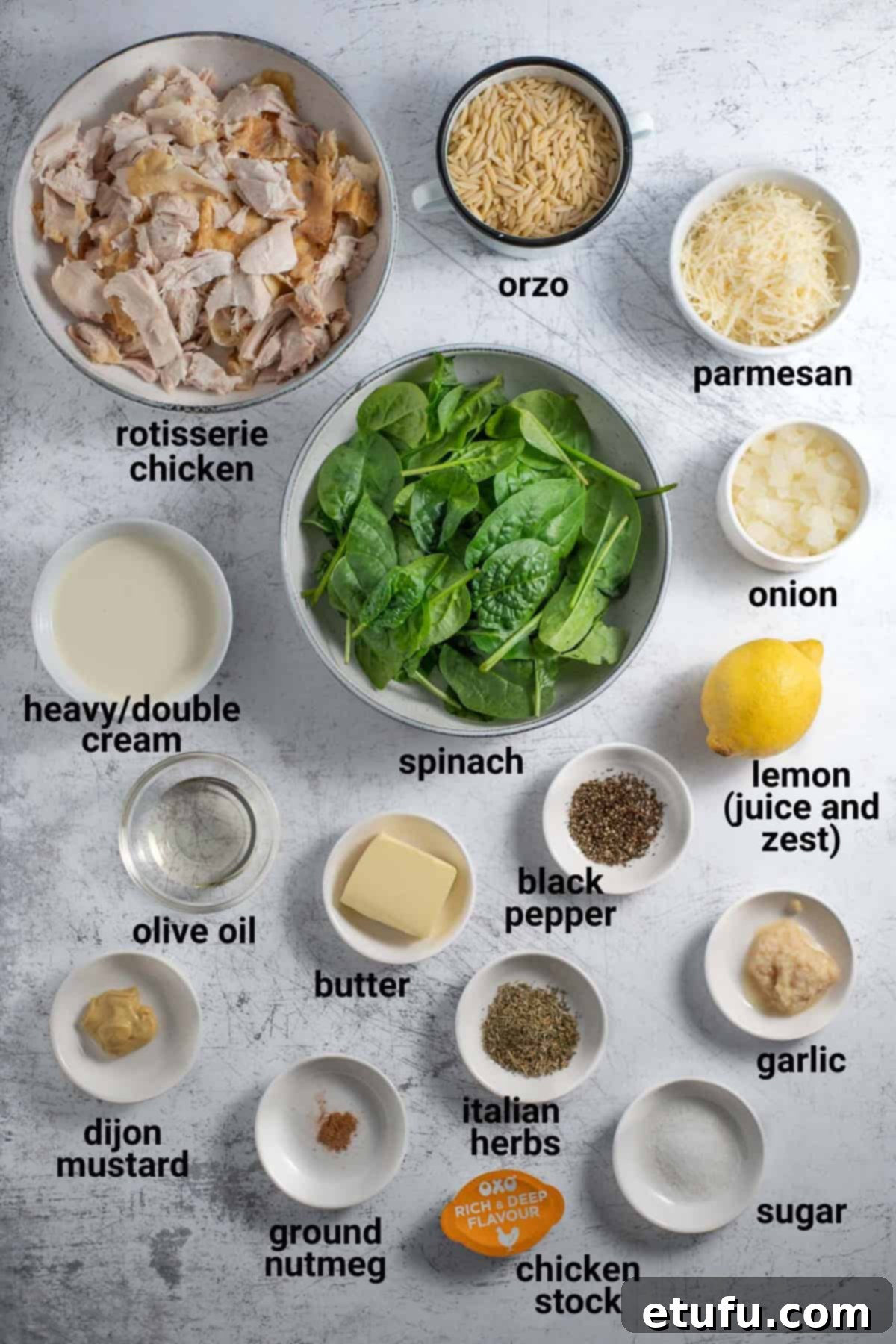
Rotisserie Chicken: The Time-Saving Flavor Boost
A medium rotisserie chicken typically yields about 3 to 4 cups of shredded meat, making it an ideal choice for speed and flavor. While we often opt for a pre-cooked chicken to streamline the cooking process, feel free to roast a whole chicken yourself if you prefer – the choice is entirely yours.
We cannot emphasize this enough: for an indulgent dish like this, incorporating some of the crispy chicken skin is a game-changer. It introduces incredible depth of flavor, a beautiful hint of color, and a pleasing textural contrast that elevates the entire experience. However, if you prefer to omit it, the dish will still be delicious.
Beyond rotisserie, any cooked chicken works wonderfully here. Whether it’s leftover shredded or diced breast, thigh meat, or even chicken from another meal, its versatility makes this recipe adaptable to what you have on hand.
Orzo: The Tiny Pasta That Packs a Punch
If you’re wondering, *what exactly is orzo pasta?*, you’re not alone! Orzo is a small, rice-shaped pasta, but it’s important to remember it’s made from wheat, just like any other pasta. Its diminutive size allows it to cook rapidly and absorb flavors beautifully, making it an excellent choice for one-pan dishes where it can simmer directly in the sauce.
A crucial note on orzo: it is generally not interchangeable with rice or other pasta types in this specific recipe. The precise cooking time and the quantity of liquid in this recipe are meticulously calibrated for orzo. Substituting it without significant adjustments to liquid ratios and cooking times could lead to an undesirable outcome, potentially affecting the texture and sauciness of the dish.
Heavy Cream (Double Cream): The Secret to a Velvety Sauce
We specifically call for heavy cream (also known as double cream in some regions) because it is indispensable for achieving that signature rich, velvety texture in the sauce. More importantly, heavy cream boasts a higher fat content, which makes it incredibly stable under heat.
Thinner creams, such as single cream or half-and-half, have a lower fat content and are much more prone to splitting or curdling when simmered, especially when acidity from lemon juice is introduced. To ensure a consistently smooth, luscious, and indulgent finish, always opt for heavy cream. If you find yourself without it, full-fat crème fraîche is a more stable and suitable alternative due to its similar fat content and inherent acidity.
Lemon: Zest and Juice for Brightness
Lemon is a star in this dish, used in two forms for maximum impact. The lemon zest, added during the simmering stage, infuses the entire sauce with its aromatic oils, providing a deep, fragrant lemon essence. The fresh lemon juice, stirred in at the very end, delivers a bright, tangy acidity that cuts through the richness of the cream and cheese, balancing the flavors beautifully and preventing the dish from feeling too heavy.
Parmesan Cheese: Salty, Umami Perfection
Parmesan cheese is more than just a topping; it’s an integral component that adds a complex salty, umami depth to the sauce. We highly recommend using freshly grated Parmesan (Parmigiano-Reggiano if possible) over pre-grated varieties. Freshly grated cheese melts more smoothly and offers a superior flavor and texture that truly enhances the dish.
Expert Tips for Perfect Orzo: Heat, Pan Size, & Troubleshooting
Achieving perfectly cooked orzo in a creamy sauce requires a little attention, but it’s incredibly rewarding. Here are some essential tips to guide you:
- Understand Your Stovetop: Heat levels can vary significantly between different stovetops. What one recipe considers “low” heat might be much hotter on your burner. Don’t hesitate to adjust; if things are cooking too quickly, move your pan to a smaller burner or turn the heat down further.
- Pan Size Matters: A wide pan with a larger surface area will allow liquids to evaporate more rapidly compared to a smaller, deeper pan. Be mindful of this as you simmer; if your sauce is reducing too fast, it could indicate your pan is too wide for the current heat setting.
- Trust Your Judgment: Cooking is an art, not just a science. Use your senses, particularly when caramelizing onions (they should be golden, not burnt) and simmering the orzo. Your intuition is your best tool.
- Manage Liquid Evaporation: If you notice the liquid evaporating too quickly before the orzo reaches al dente tenderness, immediately reduce the heat. You can also move the pan to a smaller, less intense burner. If necessary, add an extra splash of chicken broth or cream to ensure the orzo has enough liquid to fully cook.
- Trap Moisture with a Lid: For a brief period, if the orzo is still firm and the liquid is drying out, you can place a lid on the pan. This helps trap steam and moisture, allowing the pasta to cook more thoroughly without the sauce reducing excessively.
- Adjust for Creaminess: Don’t panic if the sauce isn’t as lusciously creamy as you envisioned after adding the Parmesan. Simply stir in a little more heavy cream, one tablespoon at a time, until you achieve your desired consistency. It’s an easy fix!
- Embrace Flexibility: Remember, cooking is about adaptation. Keep a close eye on your dish and make adjustments as you go. A slightly longer simmer, a touch more liquid, or a quick heat adjustment can make all the difference.
Easy Step-by-Step Guide to Creamy Lemon Chicken Orzo
Follow these detailed steps to create a truly unforgettable creamy lemon chicken orzo pasta:
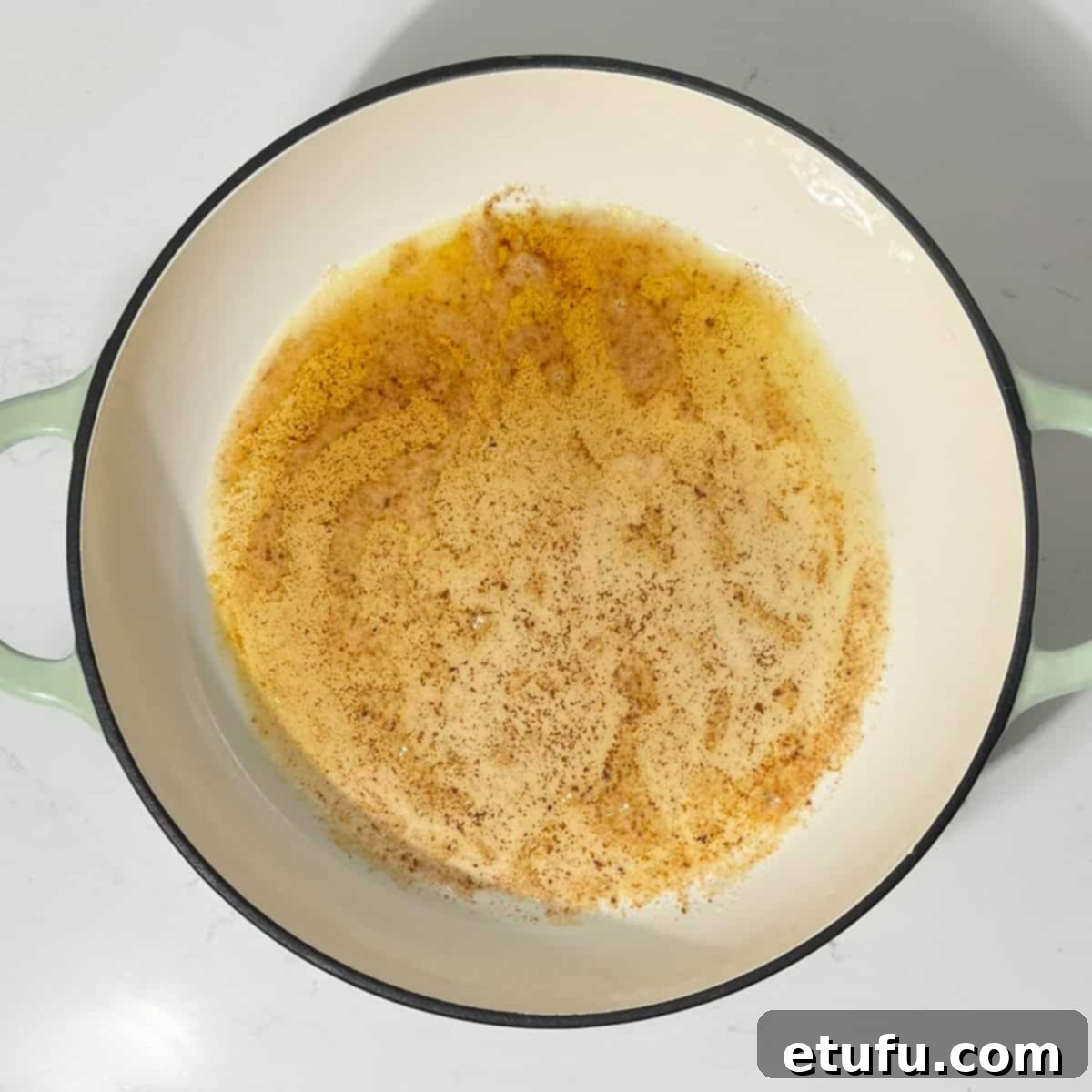
1. Brown the Butter: In a large, deep frying pan or lidded saucepan, melt the butter over medium heat. Continue cooking, stirring occasionally, until it transforms into a beautiful golden brown and releases a rich, nutty aroma. This usually takes about 3-4 minutes. You’ll notice it foams, and tiny golden specs (milk solids) will appear at the bottom of the pan. The moment it achieves this color, immediately lower the heat to low and stir in the olive oil. This crucial step prevents the butter from burning and adds another layer of flavor.

2. Caramelize the Onions: Add the diced onions and a generous pinch of sugar to the pan. Cook slowly over low heat for approximately 5-7 minutes, stirring frequently. The onions should become incredibly soft, translucent, and beautifully golden brown, indicating their natural sugars have caramelized and deepened in flavor. This slow cooking is essential for building the dish’s foundational taste.
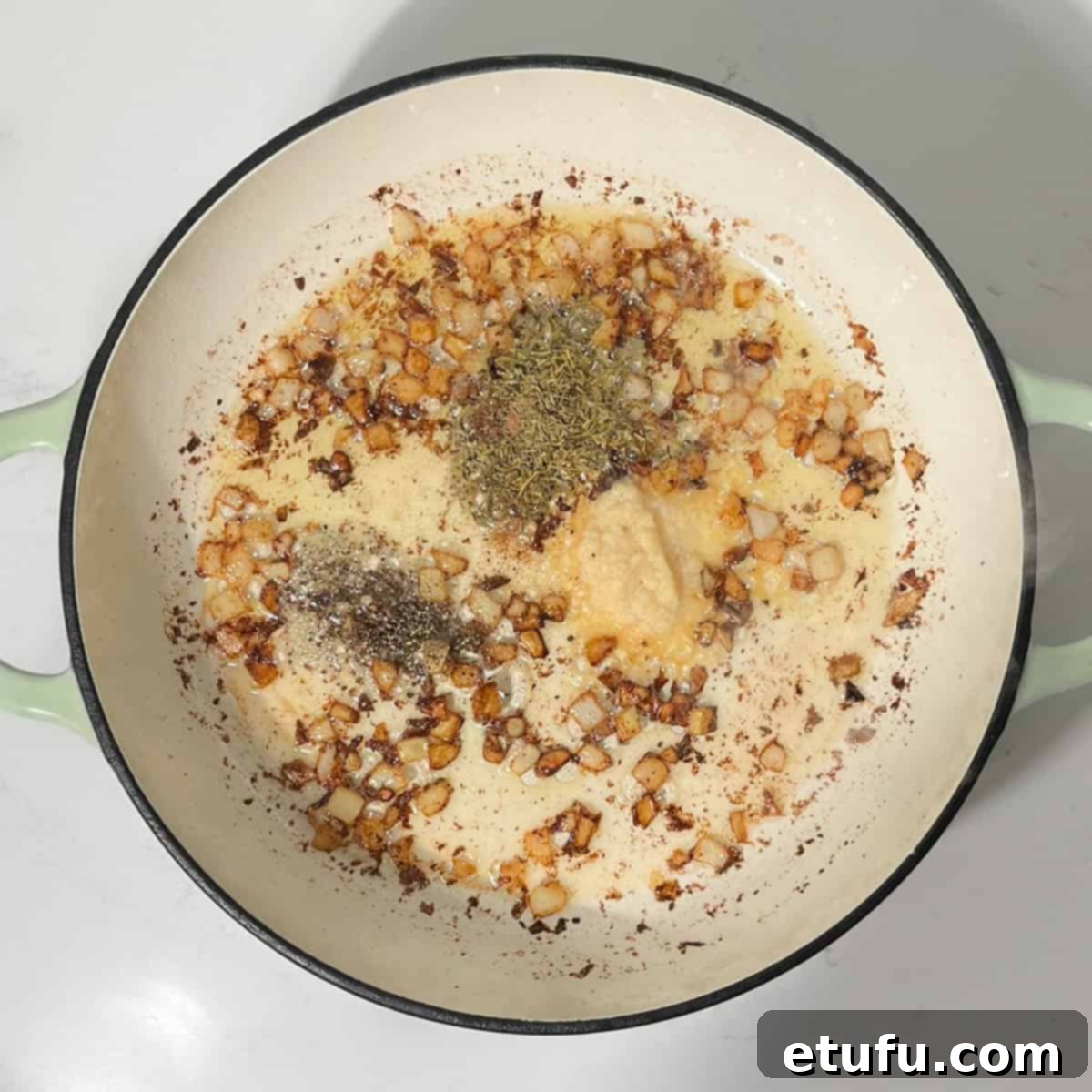
3. Bloom the Aromatics: Stir in the garlic paste (or minced cloves), Italian seasoning, a good pinch of ground nutmeg, and the cracked black pepper. Sauté for just 30 seconds, stirring constantly. This brief cooking time allows the spices to “bloom” and release their full fragrant oils, intensifying their flavors without burning the garlic.

4. Toast the Orzo: Add the dry orzo pasta directly to the pan with the onions and aromatics. Stir it through continuously over low heat for 1-2 minutes. This gentle toasting step is vital; it imparts a subtle warm, nutty flavor to the pasta and helps it retain a pleasant texture, preventing it from becoming mushy during simmering.
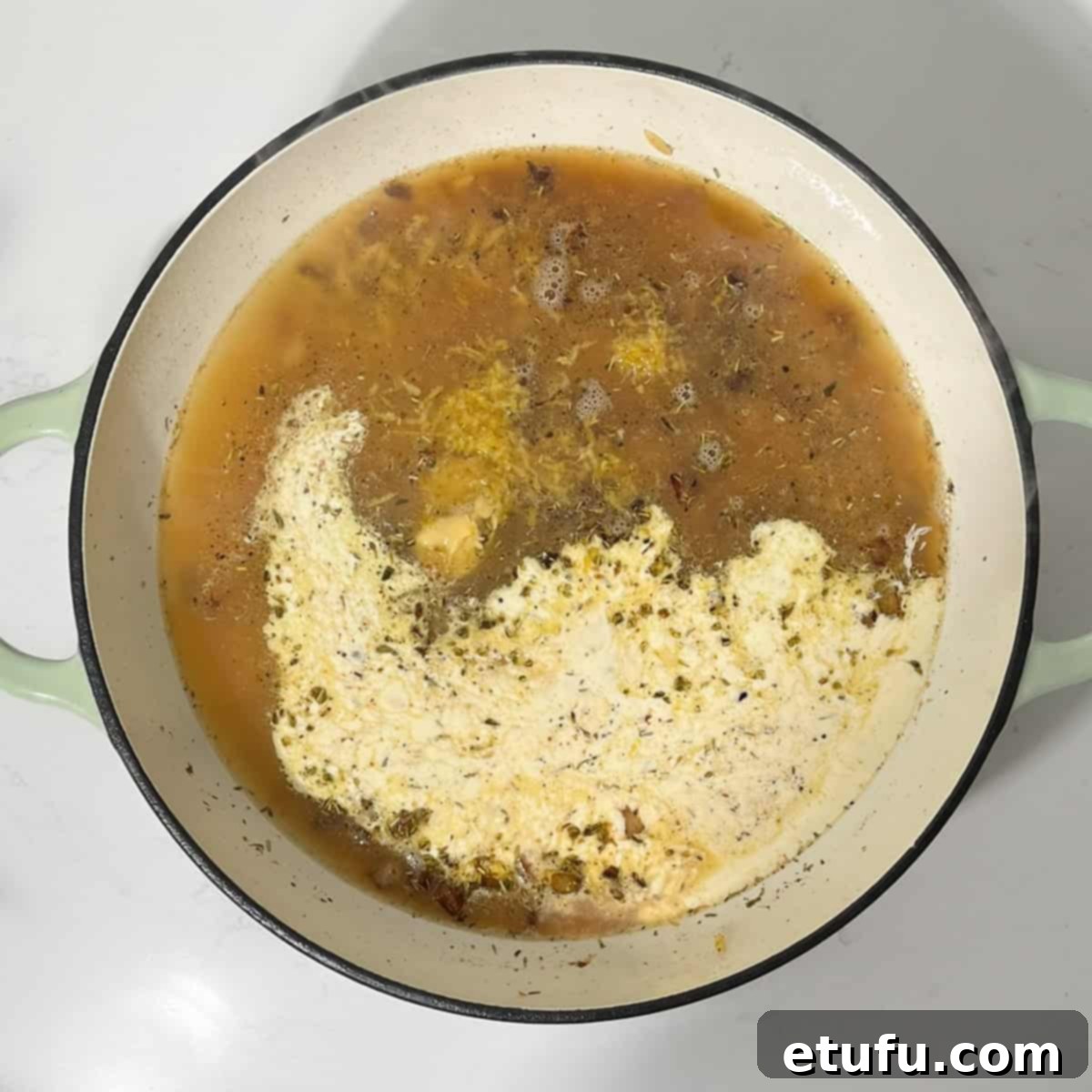
5. Begin the Simmer: Pour in the chicken broth, heavy cream, lemon zest, and Dijon mustard. Stir all the ingredients together thoroughly until well combined. Increase the heat slightly to bring the mixture to a light simmer. Ensure you scrape the bottom of the pan to incorporate any flavorful bits.
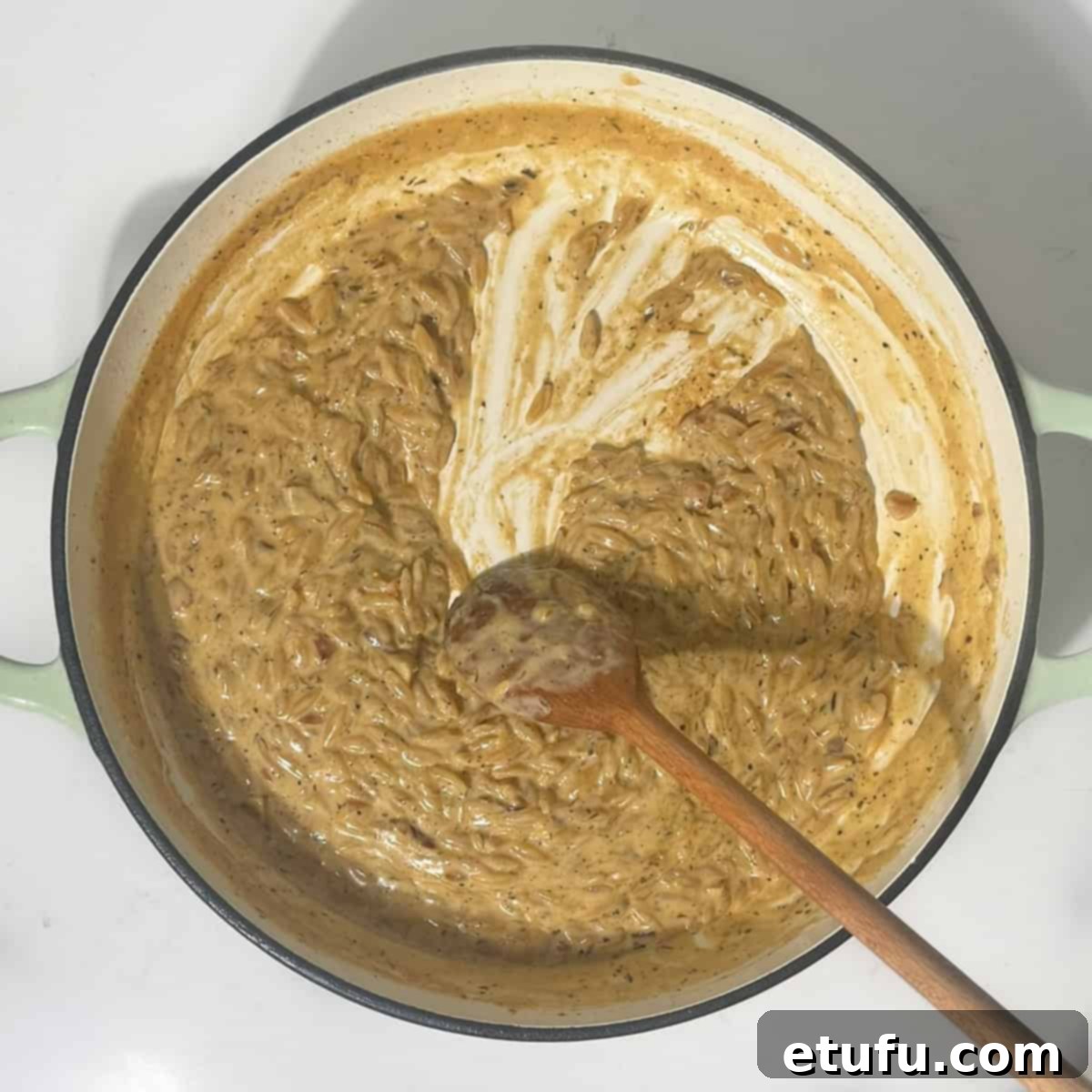
6. Simmer the Orzo: Allow everything to simmer gently, uncovered, for 8-10 minutes. This is where the magic happens! It’s crucial to stir VERY often to prevent the orzo from sticking to the bottom of the pan and ensure even cooking. Keep a close watch on both the heat and the liquid level. If the liquid seems to be evaporating too rapidly, reduce the heat further or move to a smaller burner. If needed, don’t hesitate to add an extra splash of chicken broth or heavy cream to maintain enough liquid for the orzo to cook. If after 10 minutes the orzo isn’t quite tender, continue cooking for a few more minutes. You can also briefly place a lid on the pan to help trap moisture and expedite cooking.
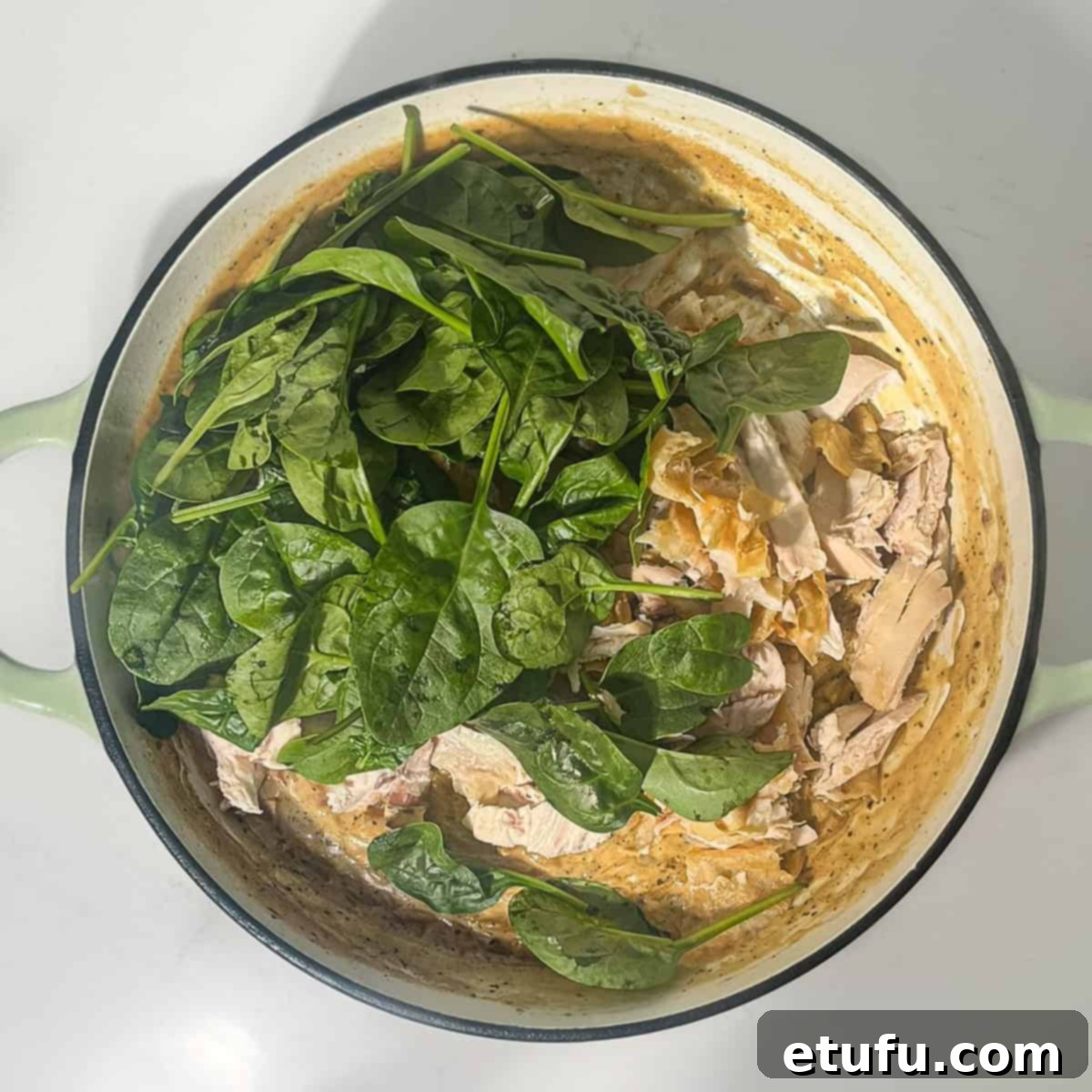
7. Add Chicken and Spinach: Once the orzo is tender (al dente is ideal), stir in the fresh spinach and the shredded rotisserie chicken. Continue to cook for just 2 minutes, or until the spinach has wilted and the chicken is thoroughly warmed through. Remove the pan from the heat immediately after the spinach wilts to maintain its vibrant color and tender texture.
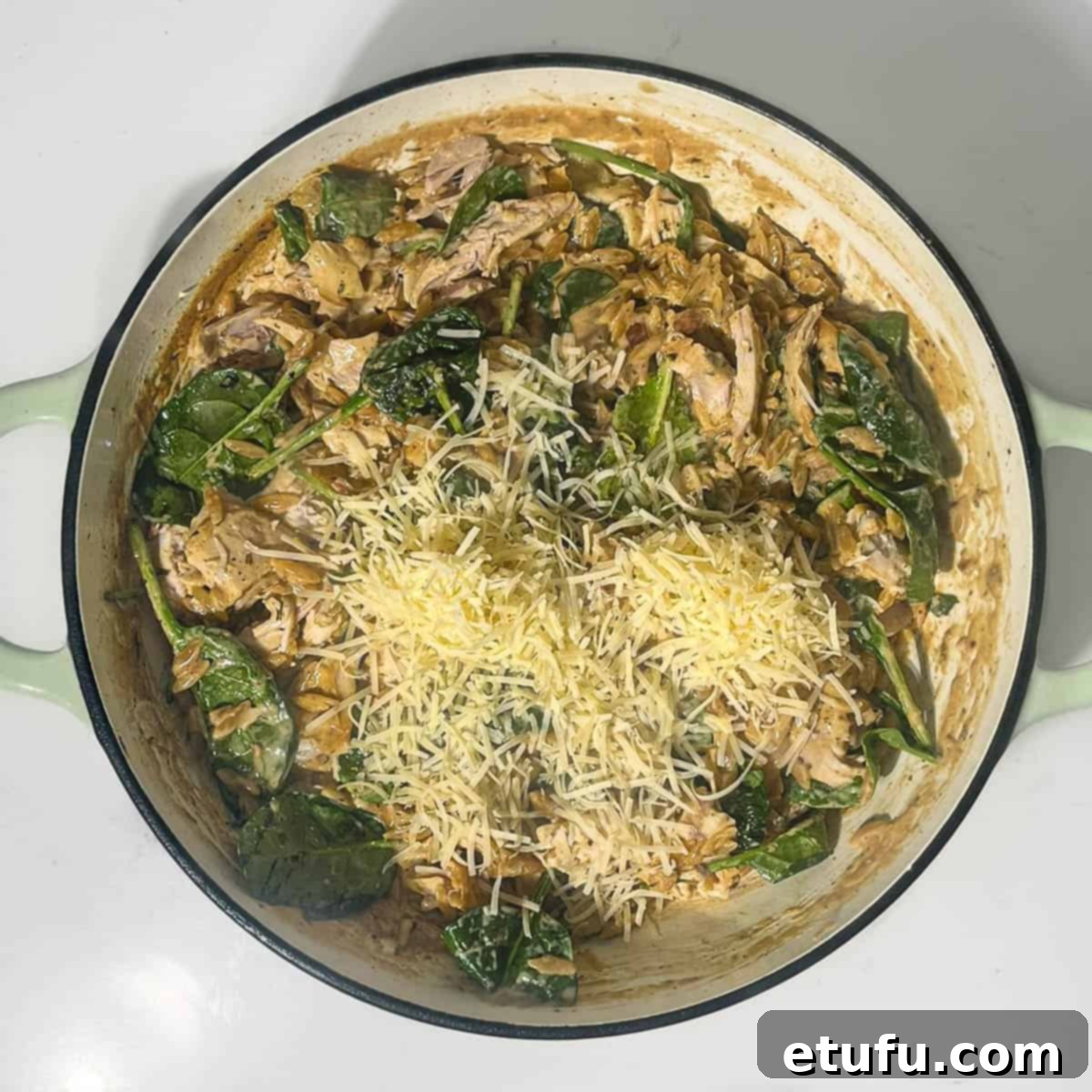
8. Final Seasoning and Creaminess Adjustment: Stir in the freshly grated Parmesan cheese and the fresh lemon juice. Taste the dish and season with salt as needed; remember, Parmesan adds significant saltiness. Feel free to squeeze in an additional dash of lemon juice if you desire an even brighter, zestier finish. If you find the sauce isn’t quite as creamy as you prefer, simply stir in an extra splash of heavy cream until it reaches your perfect desired consistency.
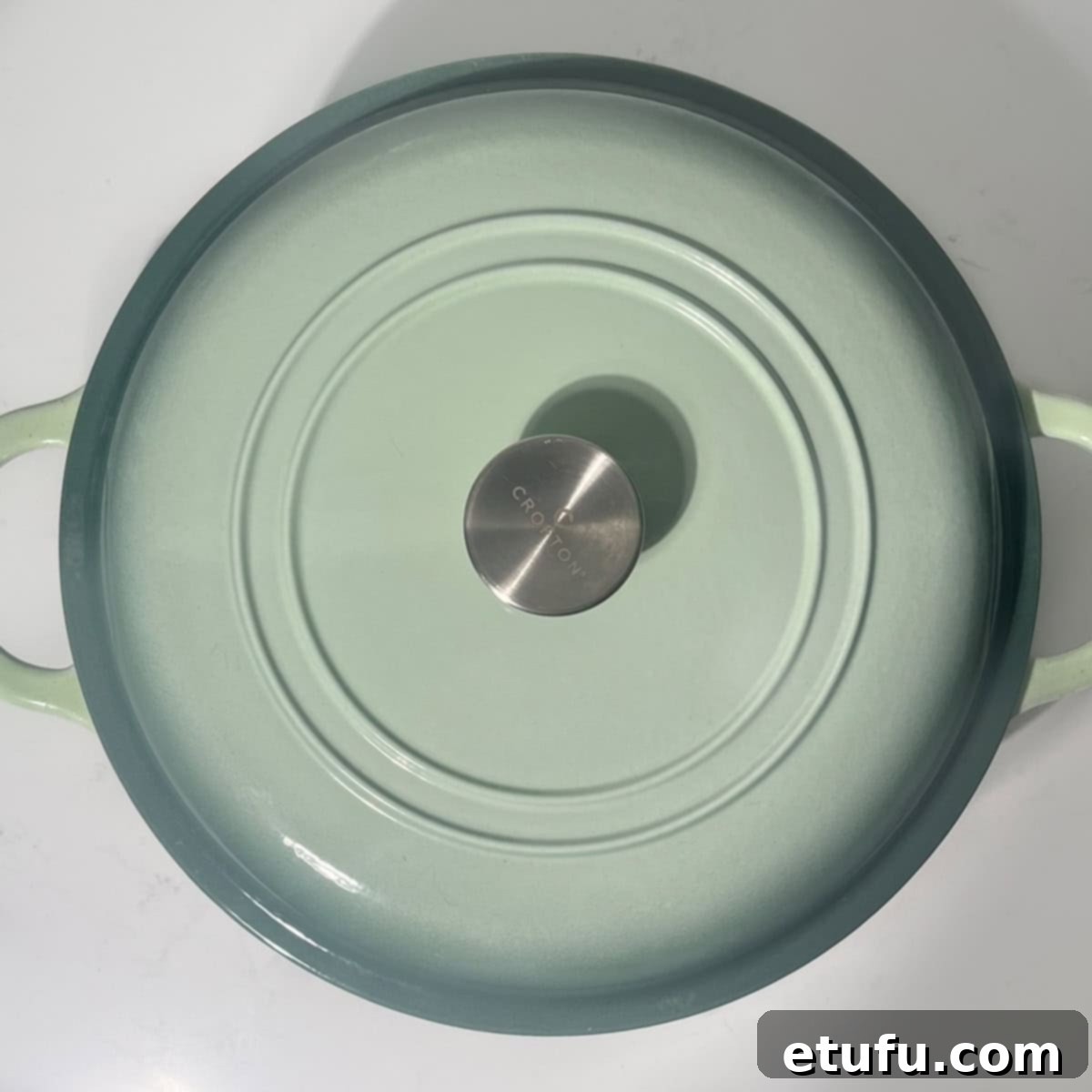
9. Rest and Absorb: Cover the pot with a tight-fitting lid and let it sit undisturbed for 10 minutes. This resting period is crucial; it allows all the magnificent flavors to meld together and the orzo to absorb any remaining sauce, resulting in an even creamier and more flavorful dish.

10. Serve and Garnish: Spoon the creamy lemon chicken orzo pasta into bowls while still warm. Garnish generously with fresh lemon slices, a good grinding of black pepper, and an extra sprinkle of Parmesan cheese over the top for that perfect finishing touch. Enjoy your homemade, elegant comfort food!
Flavor Enhancements and Creative Variations
This lemon chicken orzo pasta is undeniably indulgent and delicious as is, but its versatility means it’s ripe for personalization. Feel free to experiment and make it uniquely your own with these exciting variations:
Herb Additions: A Burst of Freshness
Fresh herbs can dramatically brighten and lift the flavors of the dish. Basil, parsley, or dill all wonderfully complement the zesty, creamy sauce. For best results, stir in a generous handful of finely chopped fresh herbs just before serving. This not only adds a burst of vibrant color but also introduces a fresh, aromatic dimension.
Spice Adjustments: Turn Up the Heat or Add Smoky Notes
If you crave a little warmth, a pinch of red pepper flakes added when sautéing the garlic will provide a subtle, welcome heat. For a more pronounced kick, a dash of chili oil can be drizzled over individual servings. Alternatively, a touch of smoked paprika introduces a delightful smoky aroma, while a hint of cayenne pepper can deliver a more intense spicy note, perfectly balancing the creaminess.
Cheese Alternatives: Exploring Different Profiles
While Parmesan offers its signature salty depth, feel free to explore other cheesy possibilities. Pecorino Romano, with its sharper, tangier bite, can add a robust character. For a milder, meltier experience, a good quality Gruyère or white cheddar could be stirred in, though they will change the traditional flavor profile.
Mediterranean Twist: A Sun-Kissed Flavor Journey
Transport your taste buds to the Mediterranean by incorporating sun-dried tomatoes and Kalamata olives. Stir these in along with the spinach and chicken for a burst of rich, savory, and briny flavors. A generous sprinkle of crumbled feta cheese on top just before serving would complete this delightful, sun-kissed variation.
Vegetable Boost: Adding More Goodness
Beyond spinach, many other vegetables can be seamlessly integrated. Sautéed mushrooms, steamed broccoli florets, or diced zucchini can be added alongside the chicken and spinach. For a burst of color and sweetness, consider stirring in some cherry tomatoes during the last few minutes of simmering.
Protein Swaps: Beyond Chicken
While chicken is a classic, this versatile orzo base can pair with other proteins. Cooked shrimp can be added at the very end to warm through, or crispy pancetta or bacon could be stirred in for an extra layer of salty, smoky flavor.
Serving Suggestions & Perfect Pairings
This creamy lemon chicken orzo pasta is a satisfying one-pot meal on its own, but pairing it with the right accompaniments can elevate your dining experience to new heights. Here are some thoughtful suggestions for side dishes, beverages, and garnishes:
Complementary Side Dishes
To beautifully balance the rich and creamy flavors of the pasta, consider these refreshing and complementary side dishes:
- Light Salads: A crisp, vibrant salad offers a refreshing counterpoint to the richness. Options like a caprese salad with hot honey dressing, a refreshing nectarine salad with basil dressing, or a rustic Panzanella salad with crusty bread and ripe tomatoes are excellent choices. Their fresh ingredients and tangy dressings cut through the creaminess perfectly.
- Roasted Vegetables: Adding a simple side of roasted vegetables provides extra texture and color. Consider roasted tenderstem broccoli with parmesan and pine nuts for an earthy crunch, or balsamic-glazed carrots for a touch of sweetness. Asparagus or green beans would also be fantastic.
- Artisan Bread: A warm loaf of garlic bread or crusty sourdough is absolutely essential for soaking up every last drop of the delectable creamy sauce. It’s the perfect mop for a truly satisfying meal.
Beverage Pairings
While fancy drinks aren’t necessary, a well-chosen beverage can enhance the meal:
- White Wine: A chilled, crisp white wine such as a Sauvignon Blanc, Pinot Grigio, or a bright Vermentino is an ideal companion. Its acidity beautifully cuts through the richness of the cream and complements the lemon notes.
- Non-Alcoholic Options: For those preferring non-alcoholic choices, sparkling water with fresh lemon slices and a sprig of mint provides a refreshing and palate-cleansing experience. A lightly brewed iced tea with citrus notes is also a delightful and sophisticated choice.
Elevating Garnishes
A final flourish can transform your homemade dish into a restaurant-quality presentation:
- Fresh Herbs: A sprinkle of freshly chopped parsley, basil, or dill just before serving adds a vibrant green color and a burst of fresh aroma.
- Extra Parmesan: You can never go wrong with a little more freshly grated Parmesan cheese scattered over the top for an extra layer of savory goodness.
- Cracked Black Pepper & Lemon: A final grinding of cracked black pepper and a last squeeze of fresh lemon juice will brighten all the flavors, bringing everything together for a truly memorable finish.
Storage and Reheating Tips for Leftovers
One of the beauties of this lemon chicken orzo pasta is how well it keeps, making it a fantastic option for meal prepping ahead of time or enjoying delicious leftovers for days to come.
Refrigeration
For best results, transfer any leftover pasta into an airtight container and store it in the refrigerator for up to 3 days. It’s important to note that the sauce will naturally thicken considerably as it cools. This is completely normal and easily remedied during the reheating process, as detailed below.
Freezing
Generally, cream-based pasta dishes do not fare well with freezing. The texture of the sauce can change significantly, often splitting or becoming grainy upon thawing and reheating. The pasta itself can also become overly soft or mushy. While not ideal, if you absolutely must freeze it, do so in individual portions to minimize thawing time and reheat very gently with added liquid to help restore the consistency. However, we highly recommend enjoying this dish fresh or refrigerated.
Reheating Methods
Bringing your leftovers back to life is simple with these methods:
- Stovetop (Recommended): This method provides the best results for restoring creaminess. Gently reheat the pasta over low heat in a saucepan. To loosen the thickened sauce and restore its original creamy texture, gradually stir in a splash of chicken broth, heavy cream, or even just a little water. Continue stirring often to prevent sticking and ensure even heating until it’s warmed through.
- Microwave: For a quick reheat, place your portion in a microwave-safe dish. Heat in 30-second intervals, stirring thoroughly between each burst. Again, add a splash of liquid (broth, cream, or water) as needed to reach your desired saucy consistency. Be careful not to overheat, as this can cause the sauce to separate.
Frequently Asked Questions About Creamy Lemon Chicken Orzo
It is not recommended to substitute orzo with other pasta types or rice. The cooking time and the specific amount of liquid in this recipe are precisely calibrated for orzo. Swapping it out would require significant adjustments to liquid ratios and cooking times, potentially leading to an undesirable texture or sauciness.
Absolutely! This dish is a great candidate for make-ahead meals. Prepare the lemon chicken orzo pasta as directed, allow it to cool completely, and then store it in an airtight container in the refrigerator for up to three days. When reheating, you’ll simply need to add a splash of broth or cream to restore its luscious creaminess.
Yes, boneless, skinless chicken breasts can be used as an alternative. Ensure they are cooked thoroughly and shredded or diced before adding them to the pasta. While rotisserie chicken, especially with some crispy skin, offers a unique depth of flavor and saves time, cooked chicken breast is a perfectly acceptable substitute.
While spinach is a classic choice, this dish is very adaptable to other vegetables. You can easily add or substitute with options like sautéed mushrooms, steamed broccoli florets, diced zucchini, or even sun-dried tomatoes. Just ensure they are cooked to your desired tenderness.
Yes, it’s simple to convert this recipe to a vegetarian version. Omit the chicken entirely and use a high-quality vegetable broth instead of chicken broth. For added substance, you can incorporate hearty vegetables like sautéed mushrooms, roasted chickpeas, or white beans.
Certainly! If you enjoy a bit of heat, you can add a pinch of red pepper flakes when sautéing the garlic. For a bolder kick, a dash of chili oil can be stirred in at the end or offered as a condiment at the table.
Creamy Lemon Chicken Orzo Pasta: The Full Recipe

Creamy Lemon Chicken Orzo Pasta (One-Pot Recipe)
Print Recipe
Save
Saved!
Equipment
- Large lidded saucepan or deep frying pan
Ingredients
- ▢ 2 tablespoons (1 oz/30g) butter
- ▢ 1 tablespoon olive oil – or other cooking oil
- ▢ ½ cup (125ml) onion, diced – roughly half a large onion
- ▢ ½ teaspoon sugar
- ▢ 2 teaspoons garlic paste – or four cloves, minced
- ▢ 1½ teaspoons Italian herbs
- ▢ good pinch of ground nutmeg
- ▢ ½ teaspoon cracked black pepper – and more for serving
- ▢ 1 cup (250ml) orzo
- ▢ 2 cups (500ml) chicken broth
- ▢ 1 cup (250ml) heavy cream – or double cream
- ▢ 1 tablespoon lemon zest – roughly one large lemon
- ▢ 1 teaspoon Dijon mustard
- ▢ 3 cups (750ml) spinach
- ▢ 3 cups (750ml) rotisserie chicken, shredded or cubed – we add some crispy skin in the mix!
- ▢ ¾ cup (180ml) Parmesan cheese, grated – and more for serving
- ▢ 2 tablespoons fresh lemon juice
- ▢ salt to taste
Instructions
- Melt the butter over medium heat until it turns golden and releases a nutty aroma – about 3-4 minutes. You’ll notice it foams and the milk solids begin to brown (little golden specs appear).
As soon as it’s browned, lower the heat and stir in the olive oil to prevent burning.
2 tablespoons (1 oz/30g) butter, 1 tablespoon olive oil - Add the onions and a pinch of sugar. Cook slowly over low heat for about 5-7 minutes until the onions are soft and beautifully golden.½ cup (125ml) onion, diced, ½ teaspoon sugar
- Add the garlic, Italian herbs, nutmeg and black pepper. Sauté for 30 seconds to bloom the flavors.2 teaspoons garlic paste, 1½ teaspoons Italian herbs, good pinch of ground nutmeg, ½ teaspoon cracked black pepper
- Add the orzo to the pan and stir it through the onions for 1-2 minutes over low heat. This lightly toasts the orzo, adding a warm, nutty flavor and helping it hold its texture.1 cup (250ml) orzo
- Pour in the chicken broth, cream, lemon zest and Dijon mustard. Stir everything together and bring to a light simmer.2 cups (500ml) chicken broth, 1 cup (250ml) heavy cream, 1 tablespoon lemon zest, 1 teaspoon Dijon mustard
- Let everything simmer gently, uncovered, for 8-10 minutes, stirring VERY often to prevent the orzo from sticking to the pan.
Keep an eye on the heat and the liquid – if it’s evaporating too quickly, lower the heat or move to a smaller burner. Add more broth or cream if needed.
If the orzo isn’t fully cooked after 10 minutes, cook for a few more minutes. You can also place the lid on to help trap moisture.
- Stir in the spinach and shredded chicken. Cook for 2 minutes until the spinach wilts and the chicken is warmed through. Remove from the heat.3 cups (750ml) spinach, 3 cups (750ml) rotisserie chicken, shredded or cubed
- Stir in the Parmesan and lemon juice. Taste and add salt if needed. Feel free to squeeze in more lemon juice if you want a brighter, zestier finish.
If the sauce isn’t as creamy as you like, add a splash more cream until it reaches your desired consistency.
¾ cup (180ml) Parmesan cheese, grated, 2 tablespoons fresh lemon juice, salt to taste - Cover the pot with a tight-fitting lid and let it sit for 10 minutes. This allows the flavors to meld and the orzo to absorb any remaining sauce.
- Serve warm with lemon slices, a generous grinding of black pepper and a good helping of extra Parmesan scattered over the top.
Notes
IMPORTANT: A quick note on heat, pan size and common sense
- Stovetops vary – your “low” might be hotter than ours. Adjust accordingly, or move to a smaller burner if needed.
- A wide pan with a large surface area allows liquid to evaporate faster than a smaller one. Factor this into your cooking time.
- Always use your judgment, especially when caramelizing the onions and simmering the orzo.
- If the liquid is evaporating too quickly before the orzo is tender, lower the heat or move to a smaller burner. Add a splash of cream or broth if needed to ensure the orzo cooks properly.
- You can temporarily place the lid on the pan to help trap moisture and aid in cooking the orzo.
- If the sauce isn’t as creamy as you desire after adding the Parmesan at the end, simply stir in a little more cream until it reaches your preferred consistency.
- Don’t stress – cooking is flexible. Keep an eye on your dish and adjust as you go to achieve the best results.
**Nutritional data disclaimer**
Please keep in mind that the nutritional information provided below is calculated by a third party and we cannot guarantee its absolute accuracy. We strive to offer the most precise information possible, but we do not take responsibility for any potential errors. Furthermore, the nutritional value of this recipe may vary depending on the exact brands and products used. We recommend consulting with a qualified healthcare professional or a registered dietitian for personalized advice regarding your dietary needs.
Nutrition
For food safety advice, including guidance on food allergies
